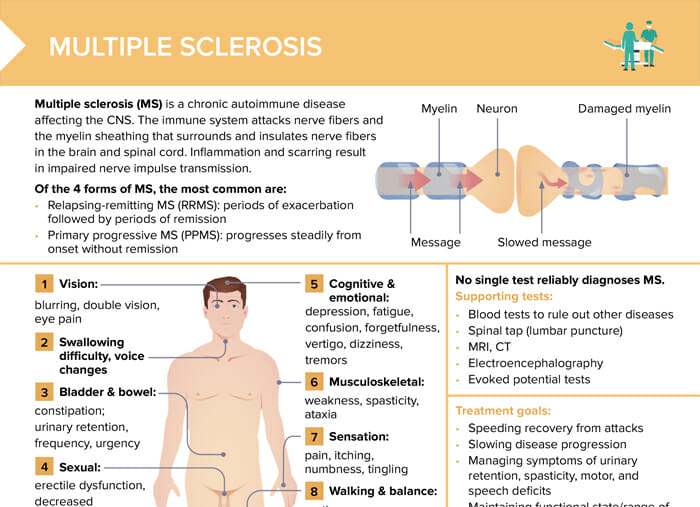What is myasthenia gravis?
Myasthenia gravis is a chronic autoimmune condition that affects a person’s muscles and nerves, causing sudden onset of fatigue and muscle weakness that worsens after activity and improves with rest.
How common is myasthenia gravis?
Myasthenia gravis affects 7–23 people per million each year, with women being more commonly affected than men.
What causes myasthenia gravis?
MG occurs when the immune system mistakenly attacks the body’s tissues. Specifically, antibodies block or destroy the neuromuscular junction (where nerves connect with muscles), disrupting the communication between nerves and muscles.
What are the common signs and symptoms of myasthenia gravis?
Common signs and symptoms of MG include:
- Drooping eyelids (ptosis)
- Blurred vision (diplopia)
- Difficulty swallowing (dysphagia)
- Shortness of breath (dyspnea)
- Difficulty speaking (dysarthria)
- Muscle weakness
- High levels of AChR antibodies in blood tests
Symptoms often worsen with activity and improve with rest.
Related videos
How is myasthenia gravis diagnosed?
Diagnosis involves a physical exam, medical history, and several tests, including diagnostic imaging such as MRI or CT scans, the edrophonium test (tensilon test), electrodiagnostics such as single fiber electromyography (EMG), pulmonary function tests, physical exams, neurological exams, and blood tests.
What are the treatment options for MG?
While there’s no cure, treatments can manage symptoms. Management options for MG include:
- Cholinesterase inhibitors such as pyridostigmine
- Plasmapheresis (blood-filtering procedure)
- Corticosteroids such as prednisone
- Thymectomy (surgical thymus removal)
- Immunosuppressants such as azathioprine
- Monoclonal antibodies such as rituximab
How can nurses help manage myasthenia gravis?
MG can impact daily activities and necessitate lifestyle changes, including adjusting work or leisure activities, adopting energy-conserving strategies, adhering to medication schedules, and managing stress to avoid exacerbation of symptoms.
Nurses can support clients by educating them about the disease, monitoring symptoms, administering treatments, managing side effects, and providing emotional support. They also facilitate communication between the client and the healthcare team.
What is a myasthenic crisis?
A myasthenic crisis is a life-threatening condition where muscles become so weak that it causes respiratory failure. This requires immediate hospitalization and assistance with breathing, usually via a ventilator.
How does the thymus gland relate to myasthenia gravis?
The thymus gland plays a role in the immune system, particularly during childhood. In most adults, it’s relatively inactive. However, in many people with myasthenia gravis (MG), the thymus gland remains large and is thought to be involved in the production of the abnormal antibodies that block or destroy the neuromuscular junction, leading to the symptoms of MG.
Some people with MG have a tumor of the thymus gland known as a thymoma. Thymomas are usually benign but can become malignant and, regardless of malignancy, make MG symptoms more likely to occur.
Thymectomy, or surgical removal of the thymus gland, can reduce symptoms in clients with myasthenia gravis.
What is acetylcholine, and how does it relate to myasthenia gravis?
Acetylcholine is a neurotransmitter, a chemical messenger that transmits signals across nerve synapses (junctions) to communicate between nerve cells (neurons). It is essential for many functions in the body, including muscle contraction and heart rate regulation.
When a person has MG, the body’s immune system produces AChR antibodies that block, alter, or destroy acetylcholine receptors at the neuromuscular junction.This prevents acetylcholine from effectively transmitting the nerve signal to the muscle, resulting in muscle weakness and fatigue.

